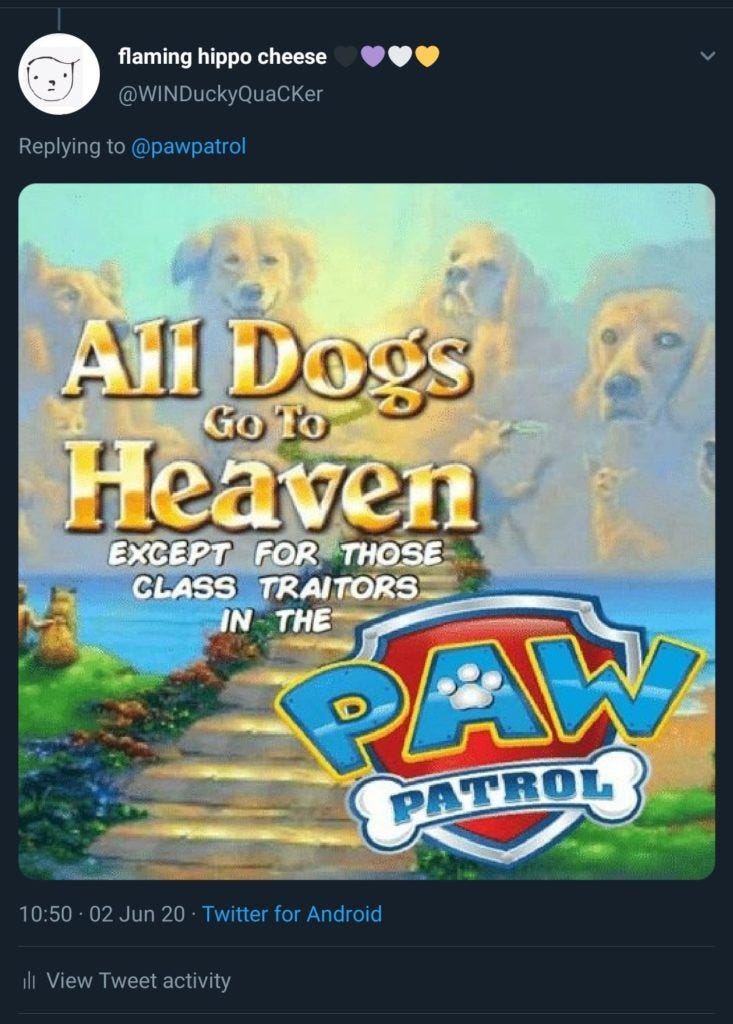The Social-Media Tail Wags the News-Media Dog
How a non-story about cancel culture coming for ‘PAW Patrol’ went viral.
Facebook serves two useful purposes: maintaining contact with extended family and monitoring developments in the culture war, like a scout on a recon mission into the dark heart of the News Feed. These two activities converged last week when I noticed that a family member had shared a report about the children’s cartoon PAW Patrol, which features a crew of anthropomorphic dogs working a variety of emergency-services jobs to protect the fictional community of Adventure Bay. The show is all the rage in the under-5 demographic. Per the story I saw on Facebook, there is a protest movement to cancel the character of Chase, a German shepherd who is a police officer, because the cute canine cop doesn’t accurately represent the ugly, irredeemable reality of law enforcement.
Skeptical, I did my own detective work. I traced the story from my family member on Facebook to a local TV station’s blurb about the controversy, whose sole source was an article in the New York Times with the headline “The Protests Come for ‘Paw Patrol’.” The top of the piece includes this:
Last week, when the show’s official Twitter account put out a bland call for “Black voices to be heard,” commenters came after Chase. “Euthanize the police dog,” they said. “Defund the paw patrol.” “All dogs go to heaven, except the class traitors in the Paw Patrol.” . . .
It’s a joke, but it’s also not. As the protests against racist police violence enter their third week, the charges are mounting against fictional cops, too. Even big-hearted cartoon police dogs—or maybe especially big-hearted cartoon police dogs—are on notice. The effort to publicize police brutality also means banishing the good-cop archetype, which reigns on both television and in viral videos of the protests themselves. “Paw Patrol” seems harmless enough, and that’s the point: The movement rests on understanding that cops do plenty of harm. The remainder of the Times story is not about PAW Patrol, but the broader rethinking of how TV fiction should portray the police given the generally positive manner in which they’re presented in popular shows such as Monk, Brooklyn Nine-Nine, and, of course, Law & Order and its innumerable spinoffs.
Since the criticism of PAW Patrol—the raison d’etre of the Times item—was sourced to a single tweet thread, I wondered: Were some of these tweets sent by activists or brand accounts of organizations prominent within the Black Lives Matter or police-reform movements? Were the tweets indicative of some wider push at work? Did they link to any petitions of note, or provide evidence of direct advocacy to the program’s crew?
Upon investigation, the answers are no, no, no, and no. Look at the sources for the tweets quoted in the Times article. The message “All Dogs Go To Heaven, EXCEPT FOR THOSE CLASS TRAITORS IN THE PAW PATROL” seems to have originated with an anonymous account that was called “flaming hippo cheese” (since renamed) with just 109 followers.

The message “DEFUND CHASE” is from an anonymous account with 50 followers, and the message “Abolish Chase” is from an anonymous account with 62 followers. The “euthanize the police dog” comment is from an anonymous account with 92 followers—this account, “Marmalade Mark,” made its header image a screengrab of a FOX News segment that featured its tweet.
This is convincing evidence of trolling, not news.
But it was apparently considered newsworthy in the broken economy of digital media, whose market participants flock to the picked-over carcasses of clickbait: local TV media all over (I mean everywhere), entertainment media, tabloid media, partisan media left and right, international media, mainstream media. It was news to the outrage merchants of social media whose 93-octane righteous indignation keeps the internet moving forward a few miles at a time. It caught the attention of Snopes: “Was the Kids’ TV Show ‘Paw Patrol’ Canceled?” it asked. No. No, it was not. “Flaming hippo cheese” and “Marmalade Mark” just don’t have that kind of power—even if they had enough to provide a New York Times cultural critic a lede for a story that spawned a thousand other stories, which in totality willed a nonexistent controversy into being.
A couple of years ago I wrote a piece about the way that outrageous “news” on social media—indicated, essentially, by its level of virality—can become “news” in the mainstream press, even about topics as serious as a Supreme Court confirmation hearing. Today the topics are as essential to American life as systemic police abuse and racism in law enforcement. They are matters so sensitive, drowning in pain and history and misunderstanding, that there is no room for sideshows: for average Americans to see vital debates about the social fabric as a farcical debate about a children’s show. And yet, through the spontaneous and decentralized cooperation of irrelevant social media trolls, the leading U.S. newspaper, digital media, and culture warriors, here we are.
On June 15, 1859, an American settler of the disputed territory of San Juan Island named Lyman Cutlar killed a pig that had invaded his garden. Unfortunately for him—and the United States, it turned out—the pig belonged to a worker from a San Juan ranch owned by the Hudson’s Bay Company, the British trading firm. The killing precipitated a military buildup. Within two months, 461 American soldiers opposed three British warships that carried more than 2,000 men. Still, all parties seemed aware of the absurdity of the situation, including British Rear Admiral Robert Baynes. He wrote the governor of British Columbia that he would not help start “a war over a squabble about a pig.”
At least that incident and the animal responsible for it both had the virtue of being real.



